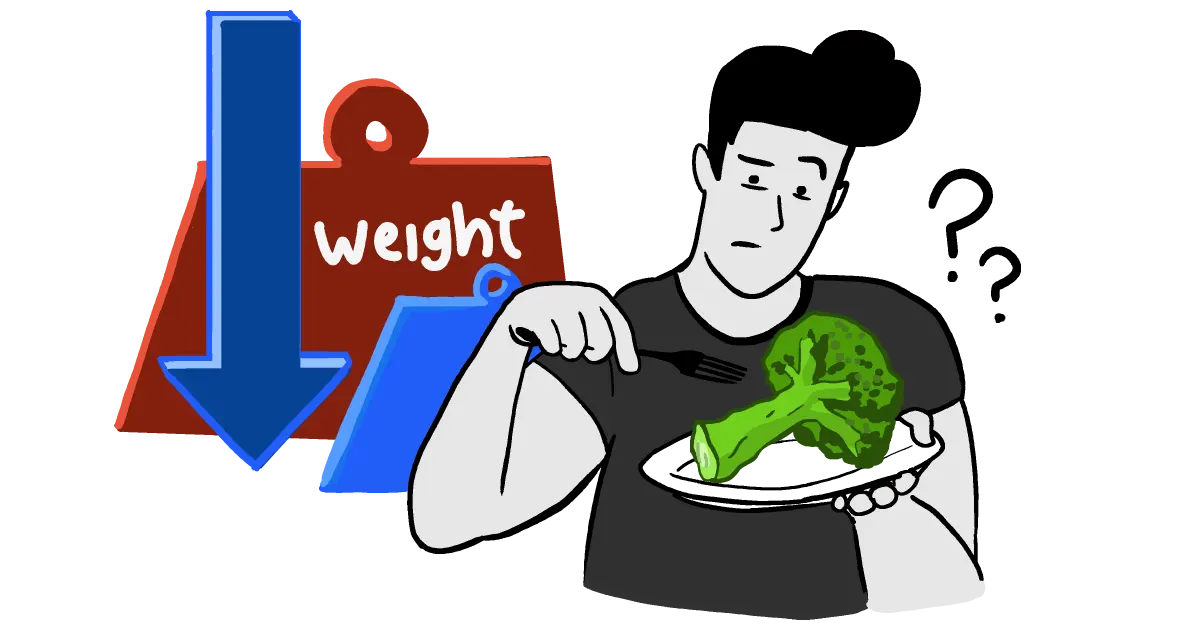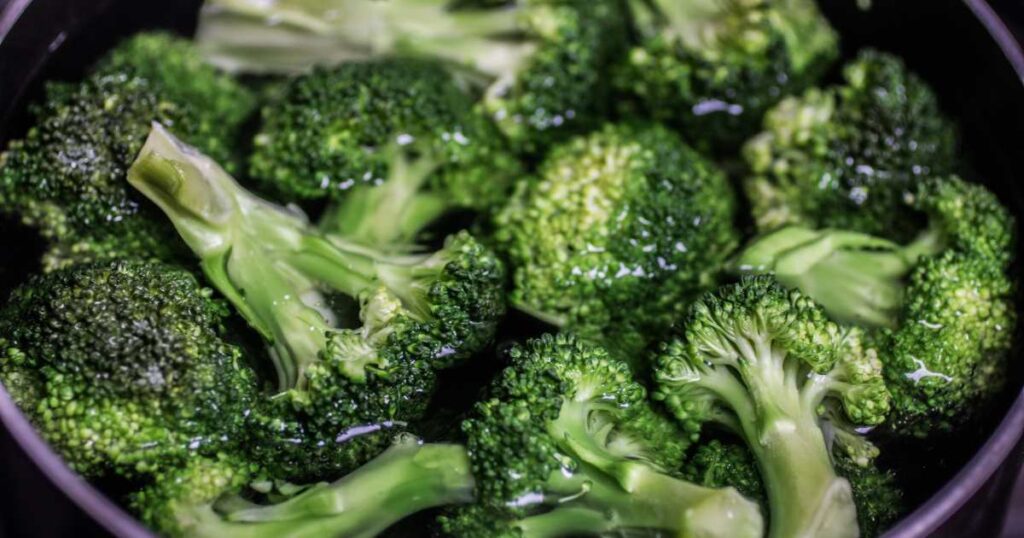
To lose weight, it’s important to consider how much broccoli you should eat, as it provides the body with fiber, vitamins, and minerals.
While broccoli is low in calories and packed with powerful nutrients, it’s possible to have too much of a good thing.
How Much Broccoli Should You Eat a Day For Weight Loss?
As far as weight loss goes, the USDA recommends that adult women eat 2 – 4 cups of vegetables per day while adult men require 3 – 4 cups so it’s safe to say 1-4 cups of broccoli per day is ideal.1, 2
Instead of focusing solely on the quantity of broccoli to eat for weight loss, it is important to recognize that a diverse range of nutrients is essential for nourishing the body to ensure a complete diet.3
Incorporating this healthy eating strategy of variety and a minimum of 1 – 4 cups of vegetables a day alongside a 6-day workout routine plan will surely jump-start a weight loss journey.
While additional servings of vegetables above the recommended amount will give the body more vitamins and minerals, research shows that it likely does not result in more weight loss.4
One study compared two groups of people and placed both on calorie-reduced diets with vegetables being a staple of their diet plan. The distinguishing factor was the comparative group ate double the amount of vegetables as the control group. The study indicated a positive correlation between vegetable intake and weight loss overall, meaning that both groups lost weight. However, there were no significant findings that doubling the veggie intake led to greater weight loss for the comparative group.4
Why Is Broccoli Good For Weight Loss?
Broccoli is good for weight loss because it belongs to the group of non-starchy vegetables which are high in fiber and water content. This combination of fiber and water creates a satiating effect and helps to control blood sugar levels.
Meaning individuals that consume broccoli regularly will be less likely to overeat, less likely to build insulin resistance, and in turn, less likely to have elevated blood sugar levels which have been associated with weight gain and diabetes.5, 6, 7
How Many Pounds Can You Lose On a Month-Long Broccoli Diet?
Estimating the amount of weight loss on a month-long broccoli diet would depend on a variety of factors such as total body fat, muscle mass, activity levels and basal metabolic rate.
In theory, if someone were to eat only broccoli for a month they could lose 8 pounds or more, but this is a dangerous route and should only be done under the supervision of a healthcare provider.
While eating 1000 calories broccoli a day for 28 days, factoring in 3500 calories burned equals a pound of fat loss and most peoples maintenance calories is 2000, here’s the break down:
- Eating 2000 Calories Per Day for a Month (28 Days) = 56,000 Calories Per Month or (2000 x 28 = 56,000)
- Eating 1000 Calories Per Day for a Month (28 Days) at = 28,000 Calories Per Month or (1000 x 28 = 28,000)
Now, let’s subtract the two and divide by 3500 to see how many pounds can be lost per month.
- 56,000 Calories per Month – 28,000 Calories per Month = 28,000 Calorie Deficit Per Month
- 28,000 Calorie Deficit Over a Month / Calories in a Pound (3500) = 8 Pounds Lost in a Month
To put this in perspective, the USDA recommends a 1,000 calorie diet for a sedentary 2-year-old and 1000 calories in broccoli is about 33 cups each day.8
Suggested Reading: You can eat anything while on a calorie deficit.
All in all, a drastically low caloric and protein intake would result in significant muscle loss which is exactly why some people may have lost weight but look fatter.
Is it Okay To Eat Broccoli Every Single Day?
For most healthy individuals, it is perfectly okay to eat broccoli every day although a variety of vegetables is better. Aside from providing beneficial vitamins such as vitamin C, K, and E, daily consumption of broccoli has been shown to normalize bowel habits.9, 10
On the contrary, broccoli is known to be a gas-forming food and a trigger for irritable bowel syndrome (IBS).11 Considering this, you should determine the amount of broccoli you can eat to lose weight if you have IBS. If broccoli is causing severe gas or stomach pains, it’s advised to refrain from consuming it. Don’t be discouraged if this is the case as there are plenty of other vegetable alternatives that will allow one to get the same nutrients broccoli provides.
Individuals with a history of thyroid issues or iodine deficiency do need to be cautious of their broccoli intake as well since cruciferous vegetables like broccoli inhibit iodine uptake by the thyroid cell and could induce or worsen hypothyroidism.12
Further research is needed to accurately determine the amount of cruciferous vegetables it takes to cause thyroid dysfunction, so always ask your doctor if this is an area of concern.
How Much Broccoli is Too Much?
There are no official guidelines that propose an upper limit for the amount of broccoli to be eaten, consuming broccoli well above the USDA recommendations will likely cause stomach issues due to an overload of fiber. While fiber is an essential nutrient to regulate our bowels and help lower cholesterol, too much can lead to constipation, diarrhea, or even intestinal blockage in severe cases.13, 14
The USDA Dietary Guidelines recommends eating at least 2.5 cups of vegetables of all kinds per day and further specifies that 1.5-2.5 cups of those vegetables should be of the dark green variety like broccoli.5
So as long as you don’t exceed the recommended daily fiber recommendations, eating 1-4 cups of broccoli each day is safe for either men or women.

Will Eating Too Much Broccoli Make You Fat or Cause Weight Gain?
It’s important to remember that eating too much of any food, including broccoli, can lead to weight gain when considering how much broccoli one should eat to lose weight. If the body consumes more calories than it burns throughout the day, it will be in a caloric surplus resulting in weight gain over time.
However, since broccoli is low in calories (around 30 calories per 1 cup serving), it would be very difficult to eat enough to seriously hinder weight loss efforts. Even if someone ate two servings of broccoli at each meal, this would result in an additional 180 calories per day which is a marginal amount compared to a standard 2,000 calorie per day diet for the average person.
As long as one is not purposely overeating broccoli to a point where they feel uncomfortable, eating too much broccoli should not cause significant fat or weight gain if their diet is in check.
What’s A Good Serving Size of Broccoli?
According to the USDA, one cup of chopped broccoli, or about 10 broccoli florets is a satisfactory serving size.15 This will provide the body with about 2 grams of protein and 6 grams of total carbohydrates, with 2 of those carbohydrate grams coming from fiber.
How to Cook Broccoli for Weight Loss
Broccoli is commonly boiled, steamed, or microwaved, and how it is cooked will actually affect the nutritional content. Research indicates that boiled broccoli leads to a considerable loss of flavonoids.16
Flavonoids may sound like they provide flavor, but they are phytonutrients found in all fruits and vegetables which provide numerous health benefits including reducing the risk of chronic diseases like cancer and cardiovascular disease.17
This same study indicated that either steaming or microwaving broccoli is the best cooking method to help maintain most of its nutritional value.16
Eating Broccoli Can Help You Lose Weight
The USDA Dietary Guidelines offer a comprehensive guide on the appropriate amount of broccoli to eat for weight loss, but it’s important not to consume too much.
Follow these recommendations and include a variety of fruits and vegetables for effective weight loss solutions that are healthy and sustainable.
References
1Dietary guidelines for Americans, 2020-2025 – executive. (n.d.). Retrieved February 15, 2022, from <https://www.dietaryguidelines.gov/sites/default/files/2020-12/DGA_2020-2025_ExecutiveSummary_English.pdf>
2Vegetables. MyPlate. (n.d.). Retrieved February 15, 2022, from <https://www.myplate.gov/eat-healthy/vegetables>
3MyPlate—the vegetable group: Vary your veggies. (n.d.). Retrieved February 15, 2022, from <https://aces.nmsu.edu/pubs//_e/E139.pdf>
4Tapsell, L. C., Batterham, M. J., Thorne, R. L., O’Shea, J. E., Grafenauer, S. J., & Probst, Y. C. (2014, July). Weight loss effects from vegetable intake: A 12-month randomised controlled trial. European journal of clinical nutrition. Retrieved February 15, 2022, from <https://www.ncbi.nlm.nih.gov/pmc/articles/PMC4086735/>
5Nour, M., Lutze, S. A., Grech, A., & Allman-Farinelli, M. (2018, November 2). The relationship between vegetable intake and weight outcomes: A systematic review of Cohort studies. Nutrients. Retrieved February 15, 2022, from <https://www.ncbi.nlm.nih.gov/pmc/articles/PMC6266069/>
6Zandani G;Kaftori-Sandler N;Sela N;Nyska A;Madar Z; (n.d.). Dietary broccoli improves markers associated with glucose and lipid metabolism through modulation of gut microbiota in mice. Nutrition (Burbank, Los Angeles County, Calif.). Retrieved February 15, 2022, from <https://pubmed.ncbi.nlm.nih.gov/33931271/>
7Centers for Disease Control and Prevention. (2021, August 10). Insulin resistance and diabetes. Centers for Disease Control and Prevention. Retrieved February 15, 2022, from <https://www.cdc.gov/diabetes/basics/insulin-resistance.html>
8USDA food patterns. USDA Food Patterns | Food and Nutrition Service. (2011, September 1). Retrieved February 15, 2022, from <https://www.fns.usda.gov/usda-food-patterns>
9Mullaney, S., Posts, & Weinroth, M. (n.d.). A food production wiki for Public Health Professionals. Food Source Information. Retrieved February 15, 2022, from <https://fsi.colostate.edu/broccoli1/>
10Yanaka, A. (2018, January). Daily intake of broccoli sprouts normalizes bowel habits in human healthy subjects. Journal of clinical biochemistry and nutrition. Retrieved February 15, 2022, from <https://www.ncbi.nlm.nih.gov/pmc/articles/PMC5773831/>
11Cozma-Petruţ, A., Loghin, F., Miere, D., & Dumitraşcu, D. L. (2017, June 7). Diet in Irritable bowel syndrome: What to recommend, not what to forbid to patients! World journal of gastroenterology. Retrieved February 15, 2022, from <https://www.ncbi.nlm.nih.gov/pmc/articles/PMC5467063/>
12Babiker, A., Alawi, A., Al Atawi, M., & Al Alwan, I. (2020). The role of micronutrients in thyroid dysfunction. Sudanese journal of paediatrics. Retrieved February 15, 2022, from <https://www.ncbi.nlm.nih.gov/pmc/articles/PMC7282437/>
13Farvid, Eliassen, E, C., X, L., WY, C., & Willett. (2019, October 28). Fiber. The Nutrition Source. Retrieved February 15, 2022, from <https://www.hsph.harvard.edu/nutritionsource/carbohydrates/fiber/>
14Duke Student Health Nutrition Services. (n.d.). Fiber How Much Is Too Much? Retrieved February 15, 2022, from <https://studentaffairs.duke.edu/sites/default/files/u110/TooMuchFiber082015.pdf>
15Fooddata Central Search Results. FoodData Central. (n.d.). Retrieved February 15, 2022, from <https://fdc.nal.usda.gov/fdc-app.html#/food-details/170379/nutrients>
16Wu, X., Zhao, Y., Haytowitz, D. B., Chen, P., & Pehrsson, P. R. (2019, March 7). Effects of domestic cooking on flavonoids in broccoli and calculation of retention factors. Heliyon. Retrieved February 15, 2022, from <https://www.ncbi.nlm.nih.gov/pmc/articles/PMC6407093/>
17Panche, A. N., Diwan, A. D., & Chandra, S. R. (2016, December 29). Flavonoids: An overview. Journal of nutritional science. Retrieved February 15, 2022, from <https://www.ncbi.nlm.nih.gov/pmc/articles/PMC5465813/>